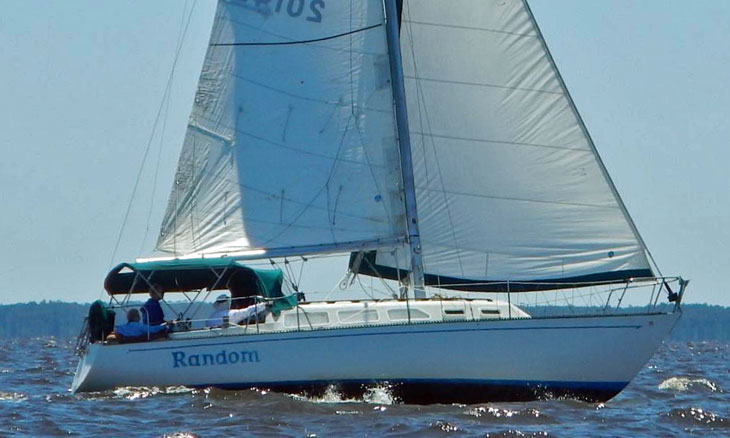- Home
- Cruising Yachts 30' to 35'
- Ranger 33
The Ranger 33 Sailboat
The Ranger 33, a masthead cruising sloop, was designed by Gary Mull and built in the USA by Ranger Yachts Inc.
 'Random', a Ranger 33 sloop under full sail
'Random', a Ranger 33 sloop under full sail'Random' is one of the later models which were produced with wheel steering. Earlier versions had a tiller.
Published Specification for the Ranger 33
Underwater Profile: Fin keel with spade rudder
Hull Material: GRP
Length Overall: 33'2" / 10.11m
Waterline Length: 26'3" / 8.00m
Beam: 9'7" / 2.9m
Draft: 5'0", 1.5m
Rig Type: Masthead sloop
Displacement: 10,500lb / 2,041kg
Designer: Gary Mull
Builder: Ranger Yachts (USA)
Year First Built: 1969
Year Last Built: 1978
Number Built: 464
Published Design Ratios for the Ranger 33
Sail Area/Displacement Ratio: 17.7
Ballast/Displacement Ratio: 42.9
Displacement/Length Ratio: 259
Comfort Ratio: 28.2
Capsize Screening Formula: 1.8
Summary Analysis of the Design Ratios for the Ranger 33
1. A Sail Area/Displacement Ratio of 17.7 suggests that the Ranger 33 will approach her maximum hull speed readily and satisfy the sailing performance expectations of most cruising sailors.
2. A Ballast/Displacement Ratio of 42.9 means that the Ranger 33 will stand up well to her canvas in a blow, helping her to power through the waves.
3. A Displacement/Length Ratio of 259, tells us the Ranger 33 is a moderate displacement cruiser, which means she'll carry all your cruising gear without it having a dramatic effect on her performance. Most of today's sailboats intended for offshore cruising fall into this displacement category.
4. Ted Brewer's Comfort Ratio of 28.2 suggests that crew comfort of a Ranger 33 in a seaway is similar to what you would associate with the motion of a coastal cruiser with moderate stability, which is not encouraging news for anyone prone to seasickness.
5. The Capsize Screening Formula (CSF) of 1.8 tells us that a Ranger 33 would be a safer choice of sailboat for an ocean passage than one with a CSF of more than 2.0.
The Ranger 33 Sailboat: A Classic Racer/Cruiser by Gary Mull
If you are looking for a fast, fun and versatile sailing boat that can handle both racing and cruising, you might want to check out the Ranger 33 sailboat. This boat was designed by Gary Mull, one of the most influential American yacht designers of the 20th century, and built by Ranger Yachts, a division of Bangor Punta, between 1969 and 1978.
The Ranger 33 is a classic example of a well-balanced, good-looking and easy-to-sail boat that has stood the test of time. In this article, we will give you an overview of the Ranger 33 sailing boat, its accommodation, hull and deck, mast and rigging, keel and rudder, and some of its pros and cons.
Overview
The Ranger 33 can accommodate up to six people in two cabins and a saloon.
It was inspired by the Cal 40, another successful racer/cruiser by Mull that won many offshore races in the 1960s. The Ranger 33 was one of the first boats to feature a reverse transom, a low cabin trunk and a subtle but attractive sheerline that gave it a modern and sleek appearance. It was also one of the last boats to be designed under the Cruising Club of America (CCA) rule, which favored long overhangs and narrow beams.
The Ranger 33 was built by Ranger Yachts, a division of Bangor Punta, in Costa Mesa, California. Bangor Punta was an early boatbuilding conglomerate that also owned Cal, O'Day and several powerboat companies. The Ranger line was created to produce performance-oriented boats that were racier than the Cal or O'Day models.
The Ranger 33 was one of the most popular models in the Ranger series, with 464 boats produced between 1969 and 1978. Many minor changes were made over the years of production, such as restyled interiors, diesel engine options and wheel steering.
The Ranger 33 has a PHRF rating of about 153, which means it is faster than many other boats of its size and era. It is still competitive in club racing today, especially in light to moderate winds. It is also suitable for coastal cruising, as it has a comfortable cockpit, a bright and airy interior and enough space for storage and living aboard for short periods. It is easy to sail and handle, with good balance and stability. It is also relatively affordable and easy to maintain.
Accommodation
The Ranger 33 has an accommodation layout that can sleep up to six people in two cabins and a saloon. The forward cabin has a V-berth with storage underneath and shelves on both sides. There is also an opening hatch for ventilation and light. The saloon has two settees that can be used as single berths or converted into a double berth with an insert cushion. There is also a folding table that can be stowed away when not in use. The saloon has four opening ports and two fixed windows for natural light and air circulation.
The galley is located on the port side of the companionway. It has a two-burner stove with an oven, a sink with a manual water pump, an icebox and some storage cabinets and drawers. The navigation station is located on the starboard side of the companionway. It has a chart table with storage underneath, an electrical panel and some instruments.
The head is located aft of the navigation station on the starboard side. It has a marine toilet with a holding tank or overboard discharge option, a sink with a manual water pump, a shower with a sump pump and some storage lockers. The aft cabin is located on the port side, behind the galley. It has a large quarter berth that can sleep two people, a hanging locker and a shelf.
The interior of the Ranger 33 is finished with teak wood trim and white fiberglass panels. The upholstery is usually blue or beige. The headroom is about 6 feet 2 inches (1.88 meters) in the saloon and 5 feet 10 inches (1.78 meters) in the forward cabin.
Hull and Deck
The hull of the Ranger 33 is made of fiberglass with a balsa core for stiffness and insulation. The deck is also made of fiberglass with a balsa core, except for the cabin top, which is solid fiberglass. The hull-to-deck joint is bonded with fiberglass and secured with stainless steel bolts. The deck has a molded-in nonskid pattern for traction and safety.
The cockpit of the Ranger 33 is spacious and comfortable, with long and wide seats that can accommodate up to six people. There is a large lazarette locker on the starboard side and a smaller one on the port side for storage. There is also a propane locker on the port side that can hold two tanks. The cockpit has a tiller or a wheel steering option, with an engine control panel and a compass mounted on the pedestal or bulkhead. The cockpit has a reverse transom with a swim ladder for easy access to the water.
The deck of the Ranger 33 has a low profile and a clean layout, with all lines led aft to the cockpit through organizers and clutches. There are two primary winches on the cockpit coaming, two secondary winches on the cabin top and two halyard winches on the mast. There are also two genoa tracks with cars and two spinnaker blocks on the deck. The deck has a bow pulpit, stern rail and stanchions with double lifelines for safety. There is also an anchor locker on the foredeck with a bow roller and a cleat.
Mast and Rigging
The mast of the Ranger 33 is made of aluminum and is stepped on the deck or on the keel, depending on the model year. The mast has two sets of spreaders and a jumper strut at the top. The mast has internal halyards for the main, jib and spinnaker. The mast has an optional fractional rig option, which has a shorter mast and a larger mainsail.
The rigging of the Ranger 33 is made of stainless steel wire with swaged terminals. The rigging has a single forestay, a single backstay, upper and lower shrouds and intermediate shrouds. The rigging has an optional baby stay or inner forestay for cutter rig option, which allows for a smaller jib or staysail.
The sails of the Ranger 33 are made of dacron or other synthetic materials. The sails include a mainsail, a jib or genoa, and a spinnaker. The mainsail has one or two reef points and slides or slugs on the luff. The mainsail has an optional in-mast or in-boom reefing system for easier handling. The jib or genoa has hanks or roller furling on the luff. The spinnaker has a pole or bowsprit for downwind sailing.
Keel and Rudder
The keel of the Ranger 33 is a fixed fin keel that is bolted to the hull with stainless steel bolts. The keel is made of lead and has a vertical trailing edge and a sloping leading edge. The keel has a moderate aspect ratio and is reasonably efficient.
The rudder of the Ranger 33 is an internally-mounted spade rudder that is attached to the hull with stainless steel gudgeons and pintles. The rudder is made of fiberglass with a foam core and has a semi-balanced shape that reduces helm pressure.
Pros and Cons
The Ranger 33 sailboat has many advantages as well as some drawbacks that you should consider before buying one. Here are some of them:
Pros:
- Fast, fun and versatile boat that can handle both racing and cruising;
- Well-balanced, good-looking and easy-to-sail boat that has stood the test of time;
- Comfortable cockpit, bright and airy interior and enough space for storage and living aboard;
- Affordable and easy to maintain boat that has many spare parts available;
- Classic design by Gary Mull that has many loyal fans.
Cons:
- Tends to develop weather helm as it heels, requiring sail reduction;
- Not very stiff or roomy compared to newer designs;
- Has some common problems such as deck leaks, chainplate corrosion, blistering, etc;
- Has limited tankage capacity for water and fuel;
- Has limited headroom in some areas.
Conclusion
The Ranger 33 yacht is a classic racer/cruiser by Gary Mull that offers fast, fun and versatile sailing that can handle both racing and cruising. It is a well-balanced, good-looking and easy-to-sail boat that has a comfortable cockpit, a bright and airy interior and enough space for storage and living aboard. It is also affordable and easy to maintain, with many spare parts available. It is a classic design by Gary Mull that has many loyal fans.
This article was written with the assistance of Gemini, a large language model developed by Google. Gemini was used to gather information, summarize research findings, and provide suggestions for the content and structure of the article.
Recent Articles
-
Is An SSB Marine Radio Installation Worth Having on Your Sailboat?
Apr 14, 25 02:31 PM
SSB marine radio is expensive to buy and install, but remains the bluewater sailors' favourite means of long-range communication, and here's why -
Correct VHF Radio Procedure: Your Questions Answered
Apr 14, 25 08:37 AM
Got a question about correct VHF radio procedure? Odds are you'll find your answer here... -
VHF Marine Radio; Which One is Right for Your Boat?
Apr 14, 25 05:09 AM
If you're looking to buy a VHF Marine Radio the choice can be a bit overwhelming. So what should it be, a fixed VHF or a handheld VHF? Maybe one with AIS or GPS built in perhaps?













